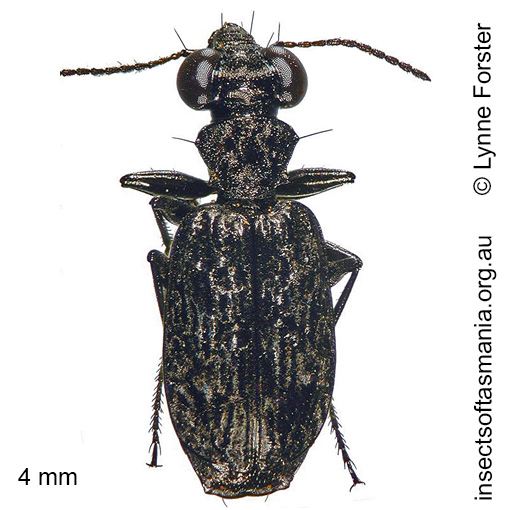
Scopodes boops Erichson, 1842 (a species of ground-beetle)
Basis for Tasmanian occurrence
Classification
Suborder: Adephaga
Superfamily: Caraboidea
Family: Carabidae
Subfamily: Harpalinae
Tribe: Pentagonicini
Morphology
Flightedness: winged and assumed capable of flight
Source literature on morphology and taxonomy (*primary taxonomic source, where identified):
*Erichson, W.F. (1842). Beitrag zur Insecten-Fauna von Vandiemensland, mit besonderer Beruecksichtung der geographischen Verbreitung der Insecten. Nicolai’schen Buchhandlung 8(1): 379 pages.
Sloane, T.G. (1920). The Carabidae of Tasmania. Proc. Linn. Soc. NSW 45: 113-178.
Ecology
Association with dead wood or old trees: at least facultatively saproxylic
Ecological attributes: — Affiliated with open montane (>900 m altitude) environments (>900 m) (Forster & Grove, 2009) — Affliliated with young (ex-clearfelled) forest (Baker et al., 2009c) — Affliliated with young (ex-clearfelled) forest (Grove, 2009) — May occupy logs or trunks of Eucalyptus obliqua, at least temporarily, since found having emerged within six years of felling (Grove et al., 2009).
Collection method(s) for TMAG material: — Emergence trapping from log of Eucalyptus obliqua — Pitfall trapping.
Source ecological literature:
Baker, S.C. (2006b). Ecology and conservation of ground-dwelling beetles in managed wet eucalypt forest: edge and riparian effects. PhD thesis, Univ. of Tasmania, Hobart.
Grove, S. et al. (2009). A long-term experimental study of saproxylic beetle … succession in Tasmanian Eucalyptus … logs… In: Fattorini, S. (Ed.), Insect Ecology and Conservation. Research Signpost, pp. 71-114.
Grove, S.J. (2009c). Do wildlife habitat strips act as refuges for mature-forest carabid beetle assemblages? A case-study in Tasmanian wet eucalypt forest, Australia. For. Ecol. Manage. 259: 496-504.

